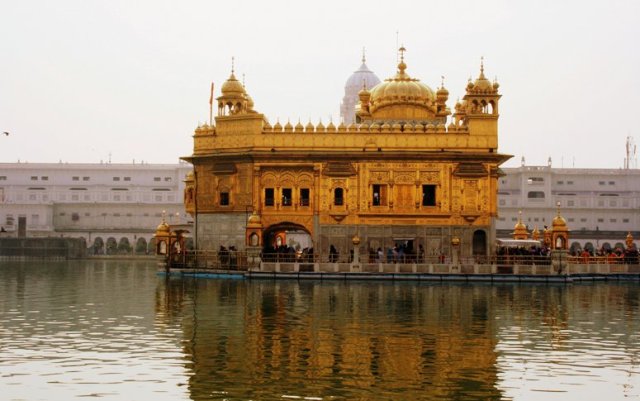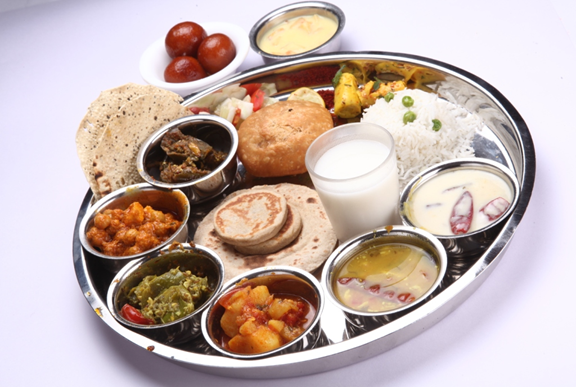Punjab, located in the north west of India, is one of the smallest and the most prosperous states of India. The five rivers Sutlej, Beas, Ravi, Chenab and Jhelum gave it its name ‘punj-ab’ or the ‘land of five waters’. Punjab is certainly a primarily agricultural state and enjoys the natural benefits of fertile soils and abundant waters. As a civilization, it is one of the most ancient in the world with a distinguished culture.
The Punjabi language has its origins in the Indo-European family of languages which also included Persian and Latin. A land of ethnic and religious diversity, it is the birth place of a number of religious movements. Some of the prominent ones include Sikhism, Buddhism and many Sufi schools of Islam.
Places to visit :
- Golden Temple
The Golden temple is also known as Harmandir Sahib or Darbar Sahib. It is a significant Sikh temple, which is located in the city of Amritsar. It is the central Gurdwara or Sikh place of worship the world over. Thousands of people visit the Golden Temple every year and is one of the most visited places in Punjab. The proper name is Harmandir which means “temple of God”, while some refer it to as darbar, which means “court”.
The temple is overlaid in the center of a sarovar or pool. The pilgrims bathe in the pool. People believe that the water has healing properties that can cure many diseases. Langar – a meal provided to all the pilgrims who visit is a free meal which is prepared in the Golden Temple. The four entrances symbolize the unity of people from all walks of life.
- Wagah Border
The Wagah border is a post between India and Pakistan. It has become famous for the retreat ceremony which includes the closing of international gates and the lowering of the flags of both the countries. Around 5000 people visit the Wagah border, which has become very popular among tourists all over the world.
The flag code of India mandates that the national flag shall be flown only from sunrise to sunset. It is an entertainment ceremony and a highly stylized patriotic display as well as an energetic performance. The guards who perform are chosen carefully among those who have great height, ability to perform and imposing stature.
- Jallianwala Bagh
Jallianwala Bagh is a place of great significance, sorrow and historical tragedy. It is witness to one of the most cruel massacres of the pre-Independence era, and hence has become the symbol of national importance and remembrance.
Jallianwala Bagh is a public garden located in Amritsar, Punjab in India. In the pre-Independence era, public rallies were organized on the grounds of Jallianwala Bagh. Inside the garden, a memorial was built in 1951. This was in remembrance of the innocent people who died in the 1919 massacre. Later on, a flame in honor of the martyrs was added. It remains to date a heartfelt and extremely sad memory in the hearts of Indians throughout the world.
· Sheesh Mahal, Patiala
This sprawling three-storied building, part-European and part-Mughal in appearance, was built by Maharaja Narendra Singh a short distance from the Old Moti Bagh Palace, to provide a space for expression for the many artists, poets and scholars who thronged his court. In its current role as a museum, this palace houses an impressive assortment of art and sculpture. It has a remarkable collection of miniature paintings, as well as carved metal and ivory artefacts from across Punjab, Kashmir, Burma and Tibet, including a gruesome albeit fascinating apron of human bones! A separate wing of the museum hosts a taxidermy gallery, displaying a large selection of mounted birds and animals.
· Anandpur Sahib Fort, Rupnagar
Anandpur Sahib, the town where the Khalsa was founded, was established by Guru Teg Bahadur on the banks of River Sutlej. It was once fortified by five majestic forts. Of these, the main fort built in red brick by Guru Gobind Singh, is still standing. A subterranean well inside the fort, accessed by a sharp flight of stairs, is an intriguing feature of its architecture. Guru Gobind Singh is said to have remained incognito within the fort’s walls when Aurangzeb’s army invaded the town in his pursuit. It is here that the annual Hola Mohalla festival is held.
· Ram Bagh Palace, Amritsar
The Ram Bagh Palace is set amidst gardens modelled on the famed Shalimar Gardens of Lahore. Named in honour of Guru Ram Das, it boasts rare plants and trees, water channels, and a well-appointed statue of Maharaja Ranjit Singh seated on a horse. Amidst this peaceful verdure, Maharaja Ranjit Singh had himself built a double-storied luxurious summer palace, with remarkably cool underground apartments for use in hot weather, in the early Indo-Sarcanic style.
A swimming pool for the ladies of the court was also constructed in close proximity to it. The palace grounds were accessed through four grand deoris (gateways) built in the Punjab architectural style marked by Rajasthani influences. Several rooms in the palace have decorative false ceilings made in the khatamband technique, a wood craft unique to Kashmir. The Palace is now the Maharaja Ranjit Singh Museum displaying a splendid exhibition from his life and expeditions, as well as, his personal sword, shield and replicas of a golden throne and the Kohinoor diamond.
· Khalsa Heritage Complex, Anandpur Sahib
The Khalsa Heritage Complex in Anandpur Sahib was begun in 1999 to commemorate the third centenary of the founding of the Khalsa Panth (Sikh nation) by Guru Gobind Singh. Spread across a generous 6,500 sq m, the museum tells a memorable story of both Punjab and Sikhism, using hand-crafted artefacts and the latest technology. Conceived as two functionally integrated sets of buildings, the Western complex, forming the gateway for the town provides pedestrian access to the Eastern complex over a 165-metre bridge. A series of reflecting pools create an expansive water body between the two complexes with arcaded walkways and gardens on either side.
· Maharaja Ranjit Singh Museum and Panorama, Amritsar
The Ram Bagh Palace was converted into a museum in 1977 and has an interesting collection of archival records from the court of Maharaja Ranjit Singh, including the attire worn by Sikh warriors, paintings, miniatures, coins, and weapons. In close proximity of the museum lies the Maharaja Ranjit Singh Panorama, a permanent visual documentation of the Maharaja’s life. This remarkable feature is housed in a large two-storied circular building and features a magnificent painting depicting six of his major battles on the upper level. Fronted by three dimensional figures replicating the scenes, it is accompanied by a multimedia representation of the sights and sounds of war. Other attractions include life-size paintings, as well as dioramas (three-dimensional scenes) of the Maharaja’s early life and one particularly notable one of his court in Lahore.
- Akal Takht
Just near the Golden Temple of Amritsar and opposite to the marbled Darshni Deorhi, the Akal Takht stands pretty. Considered the highest seat of the Sikh authority, the Akal Takht was built by Guru Hargovind in the year 1609. Shri Hargovind was the sixth guru of the Sikhs who made immense contribution to popularize the religion. Regarded as the Lord’s home, it is called – Akal Bunga.
Respected as the holiest place of the Sikhs, the Akal Takht visited by thousands of devotees every day. They offer prayers to the Gurus and seek their divine blessings. The traditional arms and weapons used by the earlier Gurus and Sikh warriors are displayed every evening at the Akal Takht.
- Bathinda Fort
Out of the many enthralling Amritsar Tourist attractions, Bathinda Fort stands in the desert areas of the district. Erected by Bhatti Reo some 1800 years back today Bathinda Fort is a prime tourist spot of Amritsar. Bhatti Reo of Amritsar took the initiative of constructing a fort in the shape of a schooner in a comparatively desert land of the district. According to the historical archives of Amritsar, Guru Gobind Singh who was the tenth Master of Sikh followers, visited Bathinda Fort many centuries back. In order to commemorate the appearance of the revered Sikh Guru a gurudwara was also established near the Bathinda Fort.
· Takhat-i-Akbari, Gurdaspur (Kalanaur)
A 13-year-old Akbar was crowned emperor of Hindustan at Kalanaur where he and his advisors had camped while on a military expedition in 1556. Destined to be India’s greatest Mughal ruler, he was declared emperor by Bairam Khan immediately on learning of Humayun’s demise in Delhi. The Takht-i-Akbari, a double-tiered brick throne at one end of a platform surrounding a water tank, marks the site where the coronation ceremony was performed.
· Durgiana Temple
Depicting the bliss of Goddess Durga, Durgiana Temple of Amritsar is also called by the name of Lakshmi Narayan Temple. A dome and a tank are the prime possession of Durgiana Temple both of which are considered sacred for the Hindu followers.
The local devotees of Amritsar come to offer their prayers to holy Goddess Durga on a regular basis. However, apart from Durga Devi, Durgiana Temple is also famous for Lord Krishna and Lord Vishnu. The temple beautifully expresses the holy aura of the two Lords through its magnificent imagery.
Cuisine
Food in Punjab has predominantly been agrarian in nature, historically evidenced in the remains of granaries and other artefacts of the Indus Valley Civilisation. Dairy products, unleavened flat breads, pulses, vegetable and meat curries continue to reflect the rural temper of the state while being wedded to the residual flavours of foreign invasions; such as rice and gravies. Punjab’s geographical location with relation to the rest of the Sub-continent has meant that this region has had strong Central Asian influences both in its culture and its food. This led to the Mughal-style of cooking with thick pasty gravies, using dry fruits like cashews and almonds. And the generous use of rice, in the form of myriad pulaos, is also an essentially Mughal introduction to the kitchens of roti-loving Punjabis. As a result, Punjabi cuisine is among the richest in the country, incorporating generous quantities of milk, curd, butter, and cream in the cooking of fresh vegetables and meats.
The state is well connected with airports at Chandigarh and Amritsar, several railway stations as well as arterial national highways that link Punjab with the outside. The colorful and exuberant state also boats of a diverse natural heritage and abounds in festive celebrations throughout the year. The state where Bhangra music and dhaba culture reigns is a shopaholic’s paradise with its woolen and hosiery products, carpets, jutis and other handicrafts.
The best times to visit Punjab are the autumn and the spring seasons. The natural landscape looks breathtaking with lush mustard fields. The rustic charm of the place and celebratory spirit of the Punjabis are sure to make for a memorable travel experience.
– HINAL SHAH




14 Comments